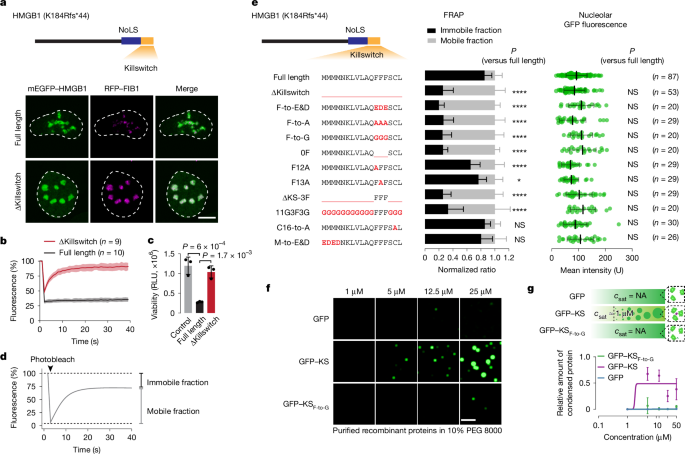用微肽灭活开关探测冷凝物微环境
IF 48.5
1区 综合性期刊
Q1 MULTIDISCIPLINARY SCIENCES
引用次数: 0
摘要
生物分子凝聚物被认为创造了与周围核质或细胞质相比具有不同物理化学性质的亚细胞微环境。然而,探究凝析物的微环境及其与生物功能的关系是一个主要挑战,因为在活细胞中选择性操纵特定凝析物的工具是有限的6,7,8,9。在这里,我们开发了一种非天然微肽(即killswitch)和一种基于纳米体的募集系统,作为探测内源性凝聚物的通用方法,并证明了凝聚物微环境与细胞功能之间的直接联系。killswitch是一个疏水的、芳香丰富的序列,具有自我结合的能力,与人类蛋白质没有同源性。当被招募到人类细胞中的内源性和疾病特异性凝聚物时,killswitch固定了凝聚物形成蛋白,导致预测和意想不到的效果。靶向核仁蛋白NPM1的杀伤开关改变了核仁组成并降低了核仁中核糖体蛋白的流动性。将杀伤开关定位于融合癌蛋白凝聚物,改变凝聚物的组成,抑制凝聚物驱动的白血病细胞的增殖。在腺病毒核凝聚体中,killswitch抑制了衣壳蛋白向凝聚体的分配,抑制了病毒颗粒的组装。结果表明,细胞凝聚物内的微环境对效应蛋白的非化学计量富集和迁移有重要贡献。killswitch是一种广泛应用的工具,可以改变内源性凝析物的材料特性,从而探索凝析物在各种生理和病理过程中的功能。本文章由计算机程序翻译,如有差异,请以英文原文为准。


Probing condensate microenvironments with a micropeptide killswitch
Biomolecular condensates are thought to create subcellular microenvironments that have different physicochemical properties compared with their surrounding nucleoplasm or cytoplasm1–5. However, probing the microenvironments of condensates and their relationship to biological function is a major challenge because tools to selectively manipulate specific condensates in living cells are limited6–9. Here, we develop a non-natural micropeptide (that is, the killswitch) and a nanobody-based recruitment system as a universal approach to probe endogenous condensates, and demonstrate direct links between condensate microenvironments and function in cells. The killswitch is a hydrophobic, aromatic-rich sequence with the ability to self-associate, and has no homology to human proteins. When recruited to endogenous and disease-specific condensates in human cells, the killswitch immobilized condensate-forming proteins, leading to both predicted and unexpected effects. Targeting the killswitch to the nucleolar protein NPM1 altered nucleolar composition and reduced the mobility of a ribosomal protein in nucleoli. Targeting the killswitch to fusion oncoprotein condensates altered condensate compositions and inhibited the proliferation of condensate-driven leukaemia cells. In adenoviral nuclear condensates, the killswitch inhibited partitioning of capsid proteins into condensates and suppressed viral particle assembly. The results suggest that the microenvironment within cellular condensates has an essential contribution to non-stoichiometric enrichment and mobility of effector proteins. The killswitch is a widely applicable tool to alter the material properties of endogenous condensates and, as a consequence, to probe functions of condensates linked to diverse physiological and pathological processes. Targeting a non-natural micropeptide ‘killswitch’ to several biomolecular condensates altered condensate compositions and revealed condensate functions in human cells
求助全文
通过发布文献求助,成功后即可免费获取论文全文。
去求助
来源期刊

Nature
综合性期刊-综合性期刊
CiteScore
90.00
自引率
1.20%
发文量
3652
审稿时长
3 months
期刊介绍:
Nature is a prestigious international journal that publishes peer-reviewed research in various scientific and technological fields. The selection of articles is based on criteria such as originality, importance, interdisciplinary relevance, timeliness, accessibility, elegance, and surprising conclusions. In addition to showcasing significant scientific advances, Nature delivers rapid, authoritative, insightful news, and interpretation of current and upcoming trends impacting science, scientists, and the broader public. The journal serves a dual purpose: firstly, to promptly share noteworthy scientific advances and foster discussions among scientists, and secondly, to ensure the swift dissemination of scientific results globally, emphasizing their significance for knowledge, culture, and daily life.
 求助内容:
求助内容: 应助结果提醒方式:
应助结果提醒方式:


